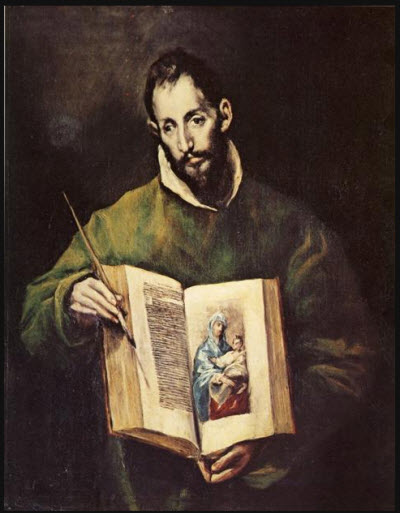Luke Images and
NotesThe Book of Luke
Luke 1:1-4 - Forasmuch as many have taken in hand to set
forth in order a declaration of those things which are most
surely believed among us, Even as they delivered them unto us,
which from the beginning were eyewitnesses, and ministers of the
word; It seemed good to me also, having had perfect
understanding of all things from the very first, to write unto
thee in order, most excellent Theophilus, That thou mightest
know the certainty of those things, wherein thou hast been
instructed.
Luke 2:49 - And he said unto them, How is it that ye sought
me? wist ye not that I must be about my Father's business?
Luke 19:42 - Saying, If thou hadst known, even thou, at
least in this thy day, the things [which belong] unto thy peace!
but now they are hid from thine eyes.
Luke in The New Testament - A Brief Overview

Painting of St. Luke by El Greco - 1605
Introduction to The
Gospel of Luke
The Word Gospel. The third book of the English
Bible that most of us read from is the Gospel of Luke.
Luke is the third of the four gospel writings, yet there is
only one gospel about Jesus Christ and there are four different
writers: Matthew, Mark, Luke, and John. The word "Gospel"
means "good news", and the good news is about Jesus
Christ dying on the cross and then 3 days later conquering death
and rising from the dead, offering salvation to all mankind,
this is the Gospel.
Summary of The Book of Luke
Brief Summary. Jesus was the most perfect man of all
men, the perfect Son of God. Completely devoted to everyone,
especially the weak. He was the most humble man that ever lived,
and not only a servant, but the lowest slave. He completely put
others first before He thought of Himself, the Son of man.
Purpose. Luke seems to portray Jesus as an ideal man,
very appealing to the Greek culture which exalted reason,
philosophy, the human mind, and beauty. Luke's writings were
orderly and classical. he mentions that Jesus spent the whole
night in prayer before He chose His apostles (Luke 6:12-16),
unlike the other Gospel accounts. There are also statements in
Luke that speak of His purity more clearly, like when the
centurion said "certainly this was a righteous man" (Luke
23:47). The other Gospel accounts seem to have a different focus
in their portrayal of Christ. Luke also seems to reveal
Christianity as a religion for all mankind and not just the
Jews. For example, the lineage of Jesus is traced past Abraham
all the way back to Adam the first man. Jesus is seen in Luke as
a friend of sinners and a savior to anyone who would believe in
Him. When considering both of Luke's works it is clear that he
traces the origin, heart, and description of the Christian
movement from Bethlehem to Jerusalem, to Antioch, to Macedonia,
to Achaia, to Ephesus, and finally to Rome, the capital of the
world. He examined eyewitnesses, knew personally and had close
contact with the main followers of Christ like Mark and James,
the brother of the Lord, Paul. Silas (a member of the Jerusalem
Church) and no doubt many others.
Audience. Luke addressed his account of the life of
Christ and the Acts of the Apostles to a man named Theophilus,
yet it possesses a style that would appeal to all intelligent
gentiles and would certain appeal to any believer. Theophilus
could have been a gentile convert to Christianity who desired to
know more of the facts surrounding the life of Jesus Christ,
possibly a wealthy contributor to Christianity, no one can say
for certain. The name Theophilus means "lover of God" and has
been supposed by many to be a euphemism for all lovers of God in
Christ.
Authorship. The gospel of Luke does not proclaim who
the author is within the document, yet the historical
information we have from the first two centuries of the
Christian Era was unanimous in concluding that the writer was
Luke. Luke also wrote the Acts of the Apostles (Acts 1:1) as a
continuing document, from the birth of John the Baptist and
Jesus to Paul's imprisonment and ministry in Rome.
Date. Since the Book of Acts was written while Paul
was in Rome, the date of Acts would be around 62 AD, and since
the Gospel of Luke was mentioned as a "former 'treatise," Luke
must have been written a few years earlier.
Place. It cannot be determined with certainty where
the Gospel of Luke was written. Some of the early Church writers
said it was written in Achaia. Many think Acts was most likely
written in Rome and therefore Luke must have also. One common
speculation is that the Gospel of Luke was written in Caesarea
Maritima while Paul was in prison there a couple years before
his journey to Rome.
The Man Luke. Luke was a gentile (non-Jew) and was not
mentioned during the actual life of Jesus, but afterward he
became a Christian under the influence of Paul the Apostle. Luke
was described by Paul in his letter to the Church in Colossae as
"the beloved physician" (Colossians 4:14). Luke was also
mentioned as a companion of Paul on his missionary journeys, and
on his third and last missionary journey he said that "only Luke
is with me" (2 Timothy 4:11). Luke must have been an amazing man
because he claims in the beginning of his account of the life of
Christ that he "investigated everything carefully" (Luke 1 :1-
4). This would mean that he would have spoken with eyewitnesses
to the miracles and events surround the ministry of Jesus. He
was clearly persuaded by the facts that he was told and became a
devoted follower of Christ and a companion of Paul until the
end. There can be no doubt that Luke was a gentile believer,
even his name "Luke" is a gentiloe name. Also in Colossians 4 it
mentions the names Epaphras, Demas and Luke in contrast with
those "of the circumcision." It is interesting to note that
early Church leaders Irenaeus, Tertullian, Origen, and Eusebius
mentioned in their writings that Luke was influenced by Paul
when he wrote the third Gospel account.
Language. Luke was written in Greek, he was a gentile
believer and uses a style similar to other important Greek
documents. He uses a popular, non-literary Greek style, omitting
Semitic and Latin "barbarisms"; yet, he manifests a rich vocabulary and a high
degree of literary artistry, as seen in his ability to sketch
the character of an individual in a few graphic strokes of the
pen. A noted French philosopher and critic of the Bible called the
book of Luke
"the most beautiful book ever written."
Historical Trustworthiness. Throughout the history of
the Church and especially during the 1800's their has been many
targeted attacks on the historical trustworthiness of Luke's
writings. As the science of archaeology increased
technologically and archaeological discoveries from the first
century were being uncovered, Luke's writings were emerged as
extremely accurate. Luke has been heralded by many scholars as
one of the ablest and most accurate historians of the ancient
world.
Outline of the Book of Luke
His Birth, Childhood, Early Ministry - Chapters 1:1-4:13
His Ministry in Galilee - Chapters 4:14-9:50
His Journey to Jerusalem, Ministry - Chapters 9:51-21:38
His Rejection and Death - Chapters 22:1-23:56
His Resurrection and Ascension - Chapter 24:1-53

The Name Jesus In Ancient Hebrew Text
"Yeshua" in First Century Hebrew Text. This is how the name "Jesus"
would have been written in ancient Hebrew documents. The four letters or
consonants from right to left are Yod, Shin, Vav, Ayin (Y, SH, OO, A).
Jesus is the Greek name for the Hebrew name Joshua or Y'shua which means
"The LORD or Yahweh is Salvation".
Luke Resources
Outline of the Life of Jesus in Harmony
Simple Map of First Century Israel
Topographical Map of First Century Israel
Map of the Ministry of
Jesus
Map of the Roads in Ancient Israel
Map of the Roman Empire






